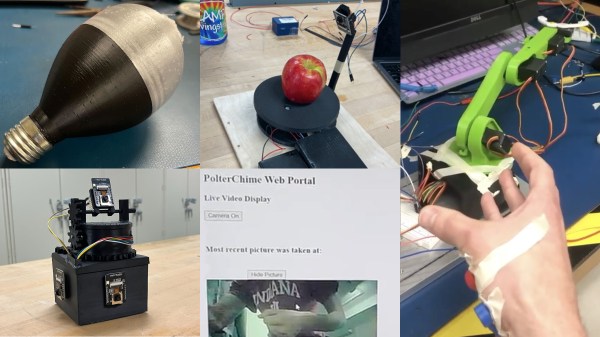
[Mr G] in London sent in his pin sentry hack. He wasn’t pleased that the device looks like an old calculator, so he rigged up a SMS board to send him his pin on demand. He multiplexed the output of the display driver to the SMS board. When he authenticates from his phone, the board sends a message with the latest code.
Robotic Sentry Gun

Reader [aaron rasmussen] and his brother Ezra built this awesome robotic sentry gun. The gun is an airsoft replica of an FN P90 and fires 6mm BBs. Pan and tilt are controlled by two hobby servos using a simple controller. Aaron wrote custom software to watch the usb webcam and track targets. There is a video on the site of it being tested
This Week In Security: WinRAR, DNS Disco, And No Silver Bullets
So what does WinRAR, day trading, and Visual Basic have in common? If you guessed “elaborate malware campaign aimed at investment brokers”, then you win the Internet for the day. This work comes from Group-IB, another cybersecurity company with a research team. They were researching a malware known as DarkMe, and found an attack on WinRAR being used in the wild, using malicious ZIP files being spread on a series of web forums for traders.
Among the interesting tidbits of the story, apparently at least one of those forums locked down the users spreading the malicious files, and they promptly broke into the forum’s back-end and unlocked their accounts. The vulnerability itself is interesting, too. A rigged zip file is created with identically named image file and folder containing a script. The user tries to open the image, but because the zip is malformed, the WinRAR function gets confused and opens the script instead.
Based on a user’s story from one of those forums, it appears that the end goal was to break into the brokers’ trading accounts, and funnel money into attacker accounts. The one documented case only lost $2 worth of dogecoin.
There was one more vulnerability found in WinRAR, an issue when processing malicious recovery volumes. This can lead to code execution due to a memory access error. Both issues were fixed with release 6.23, so if you still have a WinRAR install kicking around, make sure it’s up to date! Continue reading “This Week In Security: WinRAR, DNS Disco, And No Silver Bullets”
Zelda Guardian Sculpture Tracks Humans And Pets Via Camera
In The Legend of Zelda: Breath of the Wild Guardians are a primitive form of sentry turret that tracks the player with a watchful eye. Inspired by this, [npentrel] decided to whip up one of her own in the real world.
The build relies on a Raspberry Pi kitted out with its usual camera for machine vision purposes. It uses the Viam robot toolkit, which runs a machine learning model to detect pets and humans on the camera feed. The guardian then tracks any pets or humans that show up by turning its head, and thus the camera, with a servo controlled by a PWM signal via the Raspberry Pi’s GPIO pins. It’s all wrapped up in a nicely-decorated 3D printed model that really does look like something straight out of Breath of the Wild.
Sentry projects are a great way to learn about electronics, mechanics, and image processing techniques. It’s funny to see how advanced and complicated these projects were fifteen years ago, compared to how easy they are today with modern machine learning libraries. How times change!
Hackaday Links: March 12, 2023
With a long history of nearly universal hate for their products, you’d think printer manufacturers would by now have found ways to back off from the policies that only seem to keep aggravating customers. But rather than make it a financially wiser decision to throw out a printer and buy a new one than to buy new ink cartridges or toners, manufacturers keep coming up with new and devious ways to piss customers off. Case in point: Hewlett-Packard now seems to be bricking printers with third-party ink cartridges. Reports from users say that a new error message has popped up on screens of printers with non-HP cartridges installed warning that further use of the printer has been blocked. Previously, printers just warned about potential quality issues from non-HP consumables, but now they’re essentially bricked until you cough up the money for legit HP cartridges. Users who have contacted HP support say that they were told the change occurred because of a recent firmware update sent to the printer, so that’s comforting.
ESP32 Projects From Northwestern University’s Embedded Electronics Class
Northwestern University’s Embedded Electronics Class delivered a bumper crop of ESP-32 projects this year. The student teams recorded their progress on hackaday.io with project descriptions, logs, BOMs, diagrams, photos, and videos to share with other makers. While all utilized the web connection that the ESP32 offers some teams chose to use ESP32 Cams to incorporate photos, video, and computer vision. We love the variety of projects the teams created, some customized versions of consumer products and others new types of smart-devices. Continue reading “ESP32 Projects From Northwestern University’s Embedded Electronics Class”
Knife Throwing Machine Gets The Spin Just Right
Despite how it might appear in bad action movies, throwing a knife and making it stick in a target is no easy feat. Taking inspiration from the aforementioned movies, [Quint] and his son built a magazine-fed knife throwing machine, capable of sticking a knife at any distance within its range.
Throwing a sharp piece of metal with a machine isn’t that hard, but timing the spin to hit the target point-first is a real challenge. To achieve this, [Quint] used a pair of high-performance servo motors to drive a pair of parallel timing belts. Mounting a carriage with a rotating knife-holder between the belts allows for a spinning throw by running one belt slightly faster. The carriage slides on a pair of copper rails, which also provide power to the knife holder via a couple of repurposed carbon motor brushes.
At first, the knife holder was an electromagnet, but it couldn’t reliably hold or release the stainless steel throwing knives. This was changed to a solenoid-driven mechanism that locks into slots machined into the knives. Knives are fed automatically from a spring-loaded magazine at the back as long as the trigger is held down, technically making it full-auto. To match the spin rate to the throwing distance, a LIDAR sensor is used to measure the distance, which also adjusts the angle of the aiming laser to compensate for the knife’s trajectory.
The development process was fraught with frustration, failure, and danger. Unreliable knife holders, exploding carriages, and faulty electronics that seemingly fired of their own accord were all challenges that needed to be overcome. However, the result is a machine that can both throw knives and nurture a kid’s passion for building and programming.
Continue reading “Knife Throwing Machine Gets The Spin Just Right”
















